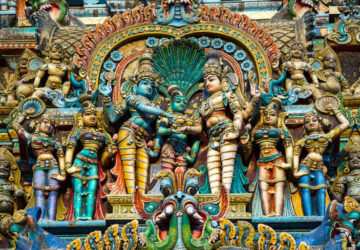
Egypt is a mystical land, and its ancient architecture has garnered curiosity from far and wide for long. While the mummies and pyramids are a popular attraction by now, Egypt’s obelisks are a major draw as well. These impressive structures were built as a symbol of the solar God Ra, Egyptians’ greatest deity. Book your holidays with our Egypt Tour Packages and explore today!

Image Source – https://upload.wikimedia.org/wikipedia/commons/4/49/Agonalis_Obelisk2007.jpg
Architectural Wonder

Image Source – https://upload.wikimedia.org/wikipedia/commons/a/af/All_Gizah_Pyramids.jpg
Paying obeisance to the Sun god, an obelisk was built to resemble a ‘petrified ray’ of the sun disk, or the ‘Aten’. A four-sided, extremely tall, narrow structure which tapers at the top, obelisks was usually placed in pairs at the entrance of the temples. Two parts primarily make up an obelisk – the quadrangular base or the body and the tapering top or the pyramidion. This pointed top was plated in gold, which the Egyptians believed was the ‘skin of the gods’. The four sides of the base could also bear inscriptions and the top, with bas-relief carvings.
Image Source – https://upload.wikimedia.org/wikipedia/commons/0/08/Heliopolis200501.JPG

Image Source – https://upload.wikimedia.org/wikipedia/commons/thumb/a/a7/SesostrisI-AltesMuseum-Berlin.png/800px-SesostrisI-AltesMuseum-Berlin.png
The first obelisk to be discovered, the Obelisk of Senusret I of the XII Dynasty at Al-Matariyyah part of Heliopolis, still stands tall. It is a massive monument which goes up to 68 feet in height and weighs approximately 120 tons. The ancient obelisks were primarily monolithic while the latter day ones were built with several stones. Consequently, this obelisk is a single structure made out of red granite. During those days, the granite quarries in Aswan provided the stone for these obelisks in Egypt.
Historical Importance

Image Source – https://upload.wikimedia.org/wikipedia/commons/2/2e/Nile_cruise_and_stay_holidays_-_panoramio.jpg
In the sacred language of ancient Egyptians, an obelisk was known as a ‘tejen’. A known fact worldwide, Egyptians have a lot of faith in the Sun god. As with the pyramids, even the obelisks’ design has been inspired by the astronomical phenomenon of the sunrise and the sunset. In the case of the obelisks, the structure of a ray was believed to penetrate through the clouds and make a way out for the negative forces which accumulate in the form of visible and invisible storms. It was this reason why the obelisks stood in front of temples of Ra, the Sun god who it is believed performs the role of protection.
So much did these structures matter, that the Egyptians had a firm belief that an obelisk housed the Sun-god himself. In Egypt, building obelisks, in fact, began from the Temple of Heliopolis, also known as the ‘City of the Sun’. It then went on to become popular in the rest of Egypt.
Obelisks Today
Believed to have been started during the Pre-Dynastic Period, the obelisks were finished building during the New Kingdom and the Ptolemaic Period.
Interestingly, though the obelisks are associated with Egypt, a lot many of them were transferred across the globe and today, less than half of the original obelisks remain in Egypt! Of the global empires, the Romans took to the obelisks strongly and consequently, the majority of them went to Rome. As on date, the tallest obelisk can be found in front of the Lateran Basilica in Rome. This one truly stands tall at 105.6 feet in height and weighs a staggering 455 tons!
However, rather, unfortunately, of these grand historical structures, only 26 original Egyptian obelisks can be found in the world, primarily in Rome and other European countries, with hardly 8 of them in Egypt itself.





Related Post
Famous Temples and Heritage Sites in Ayodhya, Uttar Pradesh
10 Famous Street Foods of Mumbai
Mount Abu: Rajasthan’s Summer Capital
15 Best Honeymoon Destinations in India in May (2024)
Get Acquainted with the Unmingled Marine life of Andamans
Your Go-To Travel Guide For Andaman Adventure Activities & Food
6 Reasons Andaman Is The Ideal Work-From-Beach Destination
Places to visit in India during long weekends 2024
Ten Interesting Facts About Serbia
15 Best Places to Visit in Serbia